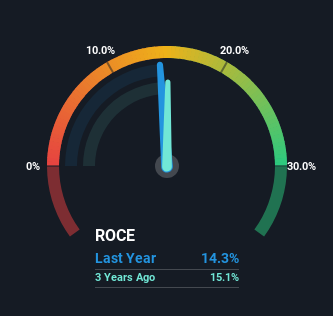Returns At Halma (LON:HLMA) Appear To Be Weighed Down

If we want to find a stock that could multiply over the long term, what are the underlying trends we should look for? Typically, we'll want to notice a trend of growing return on capital employed (ROCE) and alongside that, an expanding base of capital employed. Put simply, these types of businesses are compounding machines, meaning they are continually reinvesting their earnings at ever-higher rates of return. That's why when we briefly looked at Halma's (LON:HLMA) ROCE trend, we were pretty happy with what we saw.
Understanding Return On Capital Employed (ROCE)
Just to clarify if you're unsure, ROCE is a metric for evaluating how much pre-tax income (in percentage terms) a company earns on the capital invested in its business. The formula for this calculation on Halma is:
Return on Capital Employed = Earnings Before Interest and Tax (EBIT) ÷ (Total Assets - Current Liabilities)
0.14 = UK£377m ÷ (UK£3.0b - UK£372m) (Based on the trailing twelve months to March 2024).
Thus, Halma has an ROCE of 14%. In absolute terms, that's a satisfactory return, but compared to the Electronic industry average of 11% it's much better.
View our latest analysis for Halma

In the above chart we have measured Halma's prior ROCE against its prior performance, but the future is arguably more important. If you're interested, you can view the analysts predictions in our free analyst report for Halma .
What The Trend Of ROCE Can Tell Us
While the current returns on capital are decent, they haven't changed much. Over the past five years, ROCE has remained relatively flat at around 14% and the business has deployed 98% more capital into its operations. 14% is a pretty standard return, and it provides some comfort knowing that Halma has consistently earned this amount. Over long periods of time, returns like these might not be too exciting, but with consistency they can pay off in terms of share price returns.
What We Can Learn From Halma's ROCE
To sum it up, Halma has simply been reinvesting capital steadily, at those decent rates of return. And given the stock has only risen 39% over the last five years, we'd suspect the market is beginning to recognize these trends. That's why it could be worth your time looking into this stock further to discover if it has more traits of a multi-bagger.
Halma does have some risks though, and we've spotted 1 warning sign for Halma that you might be interested in.
While Halma isn't earning the highest return, check out this free list of companies that are earning high returns on equity with solid balance sheets.
Valuation is complex, but we're here to simplify it.
Discover if Halma might be undervalued or overvalued with our detailed analysis, featuring fair value estimates, potential risks, dividends, insider trades, and its financial condition.
Access Free AnalysisHave feedback on this article? Concerned about the content? Get in touch with us directly. Alternatively, email editorial-team (at) simplywallst.com.
This article by Simply Wall St is general in nature. We provide commentary based on historical data and analyst forecasts only using an unbiased methodology and our articles are not intended to be financial advice. It does not constitute a recommendation to buy or sell any stock, and does not take account of your objectives, or your financial situation. We aim to bring you long-term focused analysis driven by fundamental data. Note that our analysis may not factor in the latest price-sensitive company announcements or qualitative material. Simply Wall St has no position in any stocks mentioned.
About LSE:HLMA
Halma
Provides technology solutions in the safety, health, and environmental markets in the United States, Mainland Europe, the United Kingdom, the Asia Pacific, Africa, the Middle East, and internationally.
Excellent balance sheet with acceptable track record.
Similar Companies
Market Insights
Community Narratives



